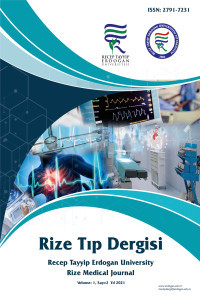22 yaşında erişkin yaşta teşhis edilen bronşektazili pulmoner hipoplaz
Tek taraflı pulmoner hipoplazi akciğerin ve pulmoner arterin değişik oranlarda az gelişmesi olarak tanımlanabilir. Hastalara genel olarak çocukluk yaşında tanı konulmaktadır. Daha nadir olarak ileri yaşta da tanı konan olgular mevcut olup literatürde vaka sunumları şeklinde kendini göstermektedir. Hastaların şikâyetleri pulmoner hipoplazinin derecesi ile yakından ilişkilidir. Bazı hastalarda sistemik sendromların bir parçası olarak görülebilmektedir. Hastaya erişkin yaşta tanı konması ve eşlik eden bronşektazi olması nedeniyle önem arz etmektedir. Hastanın çocukluk çağından itibaren eforla artan nefes darlığı olduğu öğrenildi. Öksürük ve balgam aralıklı olduğu ve eşlik eden enfeksiyonlarla ilgili olduğu düşünüldü. Pulmoner hipoplazi tansı çoğunlukla toraks bilgisayarlı tomografi (CT) anjiyo ile konulmaktadır. Öncelikle ayırıcı tanısında diyaframa patolojileri düşünülmelidir. Tedavide pulmoner rehabilitasyon; ek hastalıkların tedavisi
ve cerrahi tedavi önerilir.
Anahtar Kelimeler:
Bronşektazi, Akciğer dokusu, Pulmoner hipoplazi
Pulmonary hypoplasia with bronchiectasis diagnosed at adult age 22
Unilateral pulmonary hypoplasia can be defined as underdevelopment of the lung and pulmonary artery at different rates. Patients are generally diagnosed in childhood. Rarely, there are cases diagnosed in advanced age, and it manifests itself as case reports in the literature. The complaints of the patients are closely related to the degree of pulmonary hypoplasia. It can be seen as a part of systemic syndromes in some patients. It is important because the patient is diagnosed at an adult age and has accompanying bronchiectasis. It was learned that the patient had dyspnea that increased with exertion since childhood. Cough and sputum were thought to be intermittent and related to concomitant infections. The diagnosis of pulmonary hypoplasia is mostly made with thorax computed tomography (CT) angiography. First of all, diaphragmatic pathologies should be considered in the differential diagnosis. Pulmonary rehabilitation in treatment; treatment of additional diseases and surgical treatment is recommended.
Keywords:
Bronchiectasis, Lung tissue, Pulmonary hypoplasia,
___
- 1- Laudy JA, Wladimiroff JW. The fetal lung. 2: Pulmonary hypoplasia. Ultrasound Obstet Gynecol. 2000Oct;16(5):482-94
- 2- Boyden ea. Developmental anomalies of the lungs. Am J Surg. 1955 Jan;89(1):79-89
- 3- Schittny JC. Development of the lung. Cell Tissue Res. 2017 Mar;367(3):427-444
- 4- Porter HJ. Pulmonary hypoplasia. Arch Dis Child Fetal Neonatal Ed. 1999 Sep;81(2):F81-3.
- 5- Lee E.Y., Boiselle P.M., Cleveland R.H.: Multidetector CT evaluation of congenital lung anomalies. Radiology 2008; 247: pp. 632-648.
- 6- Bojanić K, Grizelj R, Dilber D, Šarić D, Vuković J, Pianosi PT, Driscoll DJ, Weingarten TN, Pritišanac E, Schroeder DR, Sprung J. Cardiopulmonary exercise performance is reduced in congenital diaphragmatic hernia survivors. Pediatr Pulmonol. 2016 Dec;51(12):1320-1329
- 7- Abbey P., Narula M.K., Anand R.: Congenital malformations and developmental anomalies of the lung. Curr Radiol Rep 2014; 2: pp. 71
- 8- Wong AP, Bear CE, Chin S . Directed differentiation of human pluripotent stem cells into mature airway epithelia expressing functional CFTR protein. Nat. Biotechnol. 2012; 30: 876– 882.
- 9- Moodley Y, Ilancheran S, Samuel C et al. Human amnion epithelial cell transplantation abrogates lung fibrosis and augments repair. Am. J. Respir. Crit. Care Med. 2010; 182: 643– 651.
- Başlangıç: 2020
- Yayıncı: Recep Tayyip Erdoğan Üniversitesi
Sayıdaki Diğer Makaleler
Bir çift monozigotik ikizde kopya efektli miyopik anizometropi: Bir Olgu Sunumu
An Uncommon Cause of MINOCA: Mad Honey Poisoning
Handan DUMAN, Gökhan BARUTÇU, Elif ERGÜL
Epidermolizis Bülloza ve Pylor Atrezisi
Şenol ŞENTÜRK, Gülşah BALIK, Figen KIR ŞAHİN, Mehmet KAĞITÇI
Ayhan KANAT, Bülent ÖZDEMİR, Vacide AŞIK ÖZDEMİR, Elena ROMANA GASENZER
22 yaşında erişkin yaşta teşhis edilen bronşektazili pulmoner hipoplaz
HİPOPOTASEMİ İLE GELEN PANKREAS KANSERİNE BAĞLI EKTOPİK ACTH SENDROMU: VAKA SUNUMU
Hatice BEYAZAL POLAT, Teslime AYAZ, Damla TÜFEKÇİ, Osman CÜRE, Kadir İLKKILIÇ, Uğur AVCI, Bayram KIZILKAYA
